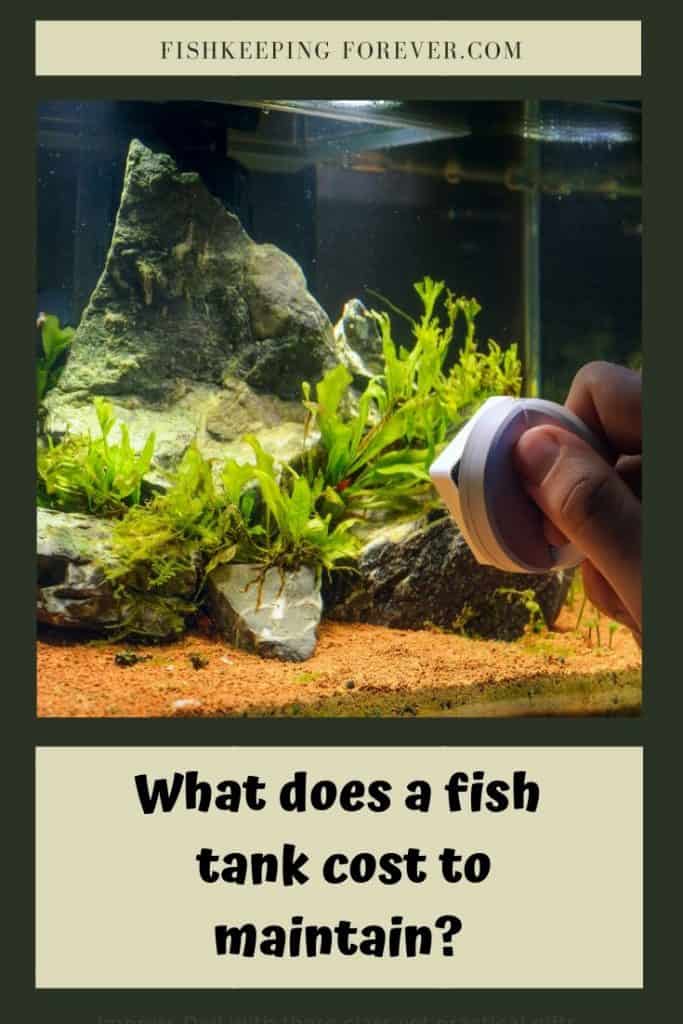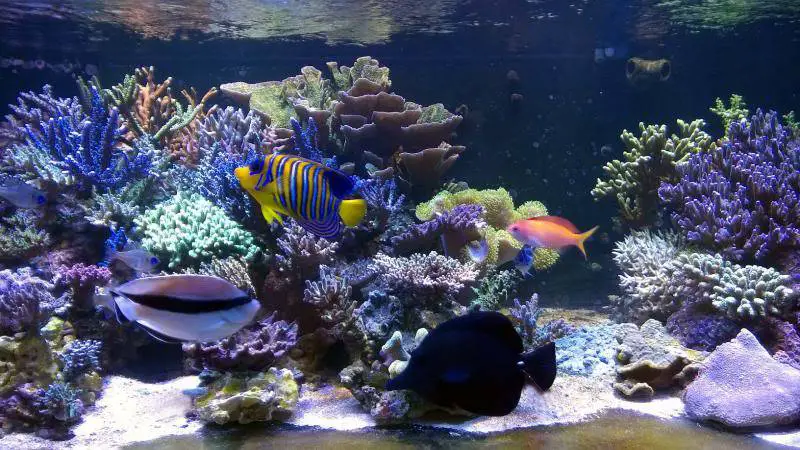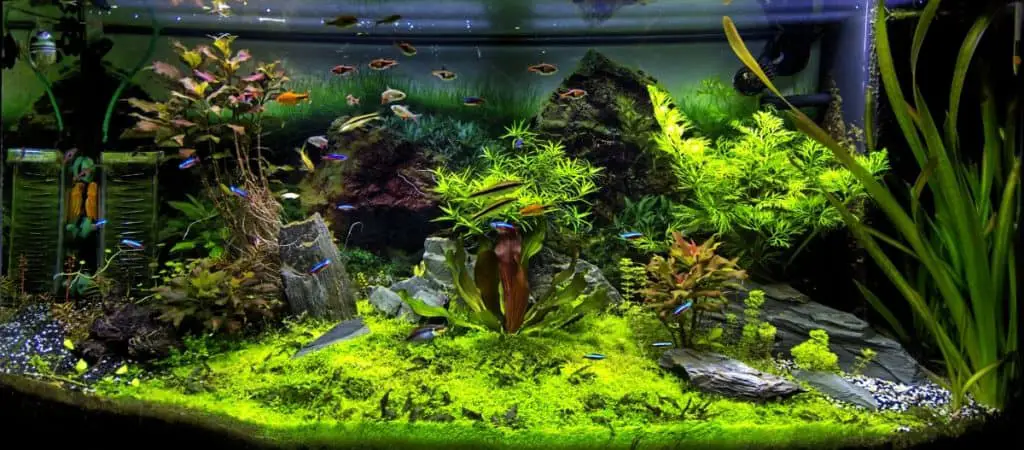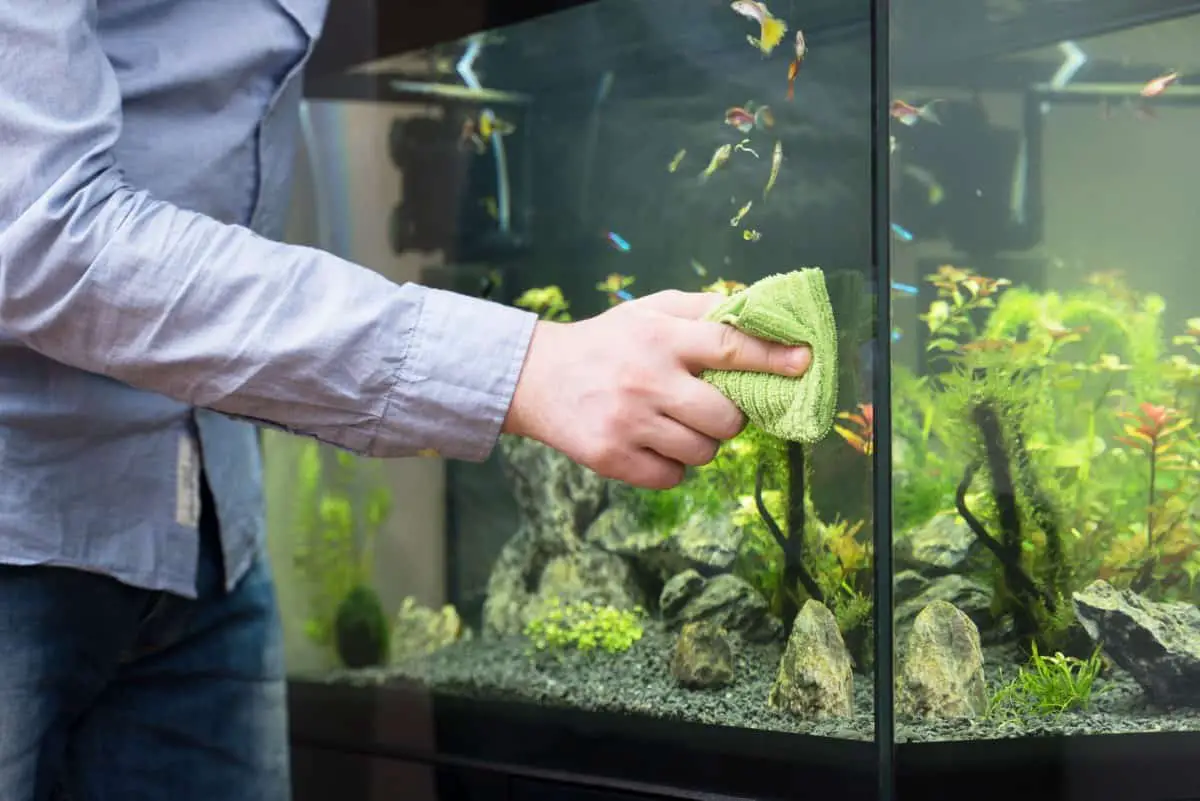In this article, we tackle the often asked question of ‘What does a fish tank cost to maintain?’ A simple enough question, especially from a complete beginner to the world of fish-keeping, however, the answer is rather complex!
When considering how much a fish tank costs to maintain, we need to consider numerous things. These include the initial purchase of the tank, the set-up and running costs. The size of your tank, the temperature and other water conditions you need to maintain, as well as the rarity and particular needs of your fish also need to be considered.
Table of Contents
What does a Fish Tank cost to Maintain?
I don’t want to start off this article by convincing you not to get into fishkeeping. But if you’re coming in with a general feeling of, ‘How cheaply can I get away with this?’, then perhaps aquarium enthusiast shouldn’t be your chosen hobby.
You can keep fish very economically and they can be one of the lowest cost and easy to maintain pets you can have. But, for fish to thrive they do need an ongoing care commitment. Therefore it helps if you have some awareness beforehand of the time and cost you will need to keep putting in.
You shouldn’t buy a fish tank just because you think it will make a stunning piece of décor in your home. Happy, healthy fish in thriving environments do make stunning pieces of décor, but this should be a bonus of fishkeeping, not your primary goal.

If you don’t spend enough time maintaining your tank then it will become unhealthy, as will your fish. If you think of cleaning and maintaining a fish tank as a tiresome chore (along the lines of cleaning a toilet or folding the laundry), then you may want to rethink getting into this hobby.
Fishkeeping is a whole process, not just the bit where you get to look at pretty fish.
You will be rewarded for the care that you put into your vibrant little community by the happy dance and joyful interaction of healthy fish in their gorgeous underwater world.
The cost of maintaining a tropical fish tank or saltwater fish tank can vary dramatically. Let’s have a look at the main factors that affect the cost of setting up and maintaining a fish tank.
What’s the most expensive aquarium ever built?
The Variables of Fish Tank Cost
I mentioned in another article that asking questions about how much fish and fishkeeping can cost is kind of like asking how long a piece of string is.
There are so many considerations and variables when asking what does a fish tank cost to maintain, that there simply isn’t a quick answer.
In general, how much a fish tank costs to buy, set up and keep running happily will depend on numerous things, including:
- · Size of your aquarium
- Temperature and other water conditions you need to maintain
- Rarity and particular needs of your fish breeds
Fishkeeping is an incredibly rewarding pastime, but it isn’t really a cheap one. If you really want to experience the beauty and connection of owning an aquarium, you need to be prepared to invest some money.
As with most things, there are two rules here:
1. You get what you pay for. If you want quality items that don’t break easily and need fixing or replacing, you’ll be better off paying more for them up front.
2. The more you want to really experience the joy of owning your own aquarium, the more you will probably want to spend.
The best advice I always give to anyone considering getting into fishkeeping is DO YOUR RESEARCH. Work out before you get started what fish you want to keep and what you want to get out of this whole experience. Make sure you know what you are getting into, because it will cost you less in the long run if you know what you’re doing from the start.
Saltwater Tanks and Saltwater Fish
While the aquariums are incredibly beautiful, many fish enthusiasts might be swayed from starting with a saltwater system from fear of cost or difficulty. Let’s have a look at the nitty gritty of saltwater aquariums and work out if you should get into this kind of fish keeping.
Saltwater tanks cost more both to start up and to maintain on an ongoing basis than freshwater tanks.
What are the Start Up Costs for a Saltwater Tank?
You will need a big enough tank for the size of fish you would like to keep. Remember that some can grow quite big; many of them like a lot of space to move around or hide. Some of them also prefer to be quite solitary and keep to themselves.
Saltwater has less oxygen than freshwater, so you need a bigger tank than you would with freshwater fish; basically, so your little guys can breathe.
You will need a strong enough stand for the tank and all of the water. It is best to buy both together or discuss with your supplier which stand would be best for your tank.
You will need:
- Aquarium
- Stand
- Sand for the base
- Saltwater mix (you can’t just add table salt to water)
- Live rock
- Water filter
- Powerhead or Jet flow to create water movement
- Lighting
- Water testing kit
- Chemicals to create suitable water to add to the aquarium
If you are going to keep more than one fish in your aquarium, you will also need a smaller tank which is your hospital/quarantine tank. Newly acquired fish need to go into this for a little while before introducing them to the rest of the community.
Cost will also depend on how big your tank is. Nano reef tanks are smaller and less expensive. However, these can be more challenging to keep due to the small water volume which makes it harder to maintain perfect water conditions.

Saltwater fish, depending on the breed, can be temperamental and will need the right amount of space to be happy. You don’t want to overcrowd a tank, nor buy one that is small – if you like to own some larger breeds of fish.
The rarer your saltwater fish breeds, the more expensive they will be to source, as well as to feed. If you choose rare and expensive fish, you probably want to invest in a good-quality tank, heater and filtration system.
In terms of cost, you can set up a perfectly good saltwater system relatively cheaply. Remember though, it will be smaller and hold less fish, and only be suitable for the hardier breeds.
Generally, you would pay at least $400-$500 for all of the equipment you need for a small (60L) saltwater system. On top of this you will need fish, and to supply the right food for them.
Long Term and Ongoing Costs for a Saltwater Tank
A saltwater tank system, as well as the fish you will buy to populate it, are both more expensive than freshwater systems. You will need to buy salt as well as water testing items regularly. You’ll also need a supply of specialized cleaning products for your tank, these can’t be swapped for general household ones.
Saltwater systems need to be properly monitored to make sure that the balance of salt and other chemicals are fine for your fish. Maintaining warm water temperature is also necessary to make sure that your tropical fish will thrive.
Your main ongoing costs for looking after a saltwater tank are; food, saltwater mix, chemicals, cleaning products and the cost of electricity to keep it running.
Saltwater fish can be quite specific in their dietary needs. This is probably the most expensive one to maintain, depending, as always, on the fish breeds you choose to keep. Some need fresh or frozen meat such as shrimp, worms, and scallops. Some need vegetable sources such as seaweed, whereas others will be happy with pellets or flakes.
Your ongoing maintenance costs for a small, basic saltwater tank system will be around $400 annually. This will increase to at least $600 annually if you need specialist food.
Things to Consider when looking after a Saltwater System
When you first set up your saltwater tank, you need to allow at least a month before you add fish. This allows rocks and plants to get established and the water levels to adjust to a healthy level for your fish.
A saltwater tank must be monitored daily to make sure that the salt levels of the water are balanced. Because in the wild, their environment is fairly stable in terms of temperature, pH level, salinity, etc. saltwater fish are used to constant conditions.
Saltwater tanks grow algae quite quickly because they have fewer living plants in them than freshwater tanks (living plants help to slow down the algae build-up). Your saltwater tank will require cleaning more frequently to contain the algae and keep your fish happy and healthy.
Saltwater Fish Tank Costs
Below is a rough breakdown of costs. However, it doesn’t include the cost of fish or things like water and power. In terms of utilities, a small running fish tank will probably cost around $200 a year; a larger one may well be cost over $1000.
Start Up
| Item | Cost |
|---|---|
| Aquarium Cost | (60L) $100 ( 120L ) $200 |
| Aquarium Stand | $85 – $200 |
| Substrate, Live Rock and Décor | $250 |
| Water Filter, Light and Heater | $350 |
| Water Testing Kit | $25 |
| Protein Skimmer | $100 |
| Small Basic Quarantine Tank set up | $250 |
| Other equipment, Net, Algae Scraper, Thermometer, Siphon | $50 |
| Salt Mix & Hydrometer | $60 |
Maintenance Cost per year
| Item | Cost Per Year |
|---|---|
| Specialist Food | $200 |
| Basic Food | $50 |
| Saltwater Salt Mix For Water Changes | $100 |
| Filter Cartridges | $20 |
| Water Chemicals and Testing | $80 |
| Medication | $20 |
| Replacement Bulbs or Tubes | $20 |
Freshwater Tanks and Freshwater Fish
Unlike just a goldfish in a bowl, a freshwater aquarium can contain a number of stunning fish. It can be a gorgeous and interesting addition to your home. When you consider the breeds of tropical freshwater fish available, your tank community will certainly be colorful and filled with personality.
The cost of your freshwater tank again depends on the size of the community you want – both in terms of start-up and maintenance costs. It is considerably cheaper than running a saltwater system, however.
What are the Start Up Costs for a Freshwater Tank?
At its very basic, you can technically own a freshwater tank with just a bowl and some water. You could buy a goldfish bowl for a child or your office desk for a complete set-up of less than $100 – your only ongoing costs will be a little container of flakes for $5 every couple of months. Simple and sweet.
While this is possible, we don’t recommend it. Your freshwater fish do need a little more than that to be happy and healthy.
You can start with a fairly small set-up if you only want one fish for example, and your initial outlay needn’t be much.
Because freshwater fish can be happy in small tanks, you don’t need to buy a specialized stand. Not unless you are buying a bigger tank. A smaller one will sit fine on a table or desk.
You will need:
- Aquarium and Stand
- Gravel for the base
- Filter
- Lighting
- Plants, decorations and places for fish to hide
- Water testing kit
If you’re considering keeping a larger freshwater community, you should also have a smaller quarantine tank. This is required for sick fish or when bringing in newcomers.
Some freshwater fish are happy in cold or room temperature water. Others, such as tropical freshwater fish, will need a heater.

Costs will depend on a few factors, including the size of the aquarium and the community of fish. If you want to keep tropical freshwater varieties, or just your hardy little friend, Goldy, then costs will vary accordingly.
You can, generally, start up a good freshwater system for between $300-$500. Fish and food will be extra, but these cost far less than saltwater. Ongoing costs are also much less.
Long Term and Ongoing Costs for a Freshwater Tank
Your ongoing costs of maintaining a freshwater system will again be food, chemicals and cleaning products and power. If you don’t run a heater, light or filter then there will be no electricity costs.
The cost of food will depend on the dietary needs of your fish breeds. Read our article on the Beginners Guide To Fish Food. This explains all you need to know about the different foods available.
Things to Consider when looking after a Freshwater aquarium
Freshwater fish, in the wild, are used to rough terrain and changing conditions. They go through periods of drought and flood and are a bit more used to the conditions and chemical make-up of their environment changing.
Hence, they are more adaptable to fluctuations in the water: You don’t need to be quite as vigilant or constant about the water condition as you do when caring for saltwater fish.
Living plants in your aquarium will help to slow down algae growth. If you invest in a few good plants you won’t need to clean your tank or change the water as often. You should still clean your tank regularly and test and change a portion of the water weekly.
For a complete guide to tropical fish food for both saltwater and freshwater fish, read our fish food guide. We explain the difference in fish food and what you should look out for when buying your pet fish food.
Freshwater Fish Tank Costs
This is a rough breakdown and doesn’t include the cost of fish or things like water and power.
Start Up
| Item | Costs |
|---|---|
| Aquarium | $100 |
| Stand | $85 |
| Substrate, Live Plants and Décor | $50 |
| Water Filter, Light and Heater | $100 |
| Water Testing Kit | $15 |
| Quarantine Tank set up | $120 |
| Other equipment, Net, Algae Scraper, Thermometer, Siphon | $30 |
Maintenance Cost per year
| Item | Cost Per Year |
|---|---|
| Specialist Food | $250 Per Year |
| Basic Food | $50 |
| Replacement Plants | $50 |
| Filter Cartridges & Parts | $50 |
| Water Chemicals and Testing | $80 |
| Medication | $20 |
| Replacement Bulbs | $20 |
5 Recommended Starter Fish Tanks
Hagen HG Fluval Flex Aquarium 57L, 15gal
Features
- The Fluval 15 gallon flex freshwater kit is one of very few freshwater aquarium Kits to incorporate brilliant illumination and multistage filtration with convenient Aquarium features and contemporary design. Your aquatic atmosphere will stand out with 48 white and 6 RGB fully adjustable 2450 lux LEDs shimmering over your fish and plants, while the 7500K LED lamp promotes Plant growth. Choose from this endless selection of color blends and the special effects options, all controlled from your included flexpad remote control. This is a fully fledged glass tank, and there is an infrared remote sensor that is neatly integrated and accessible on the canopy.To achieve superior water quality, powerful 3-stage filtration is included with oversized mechanical (foam), chemical (carbon), and biological (BioMax) media. The multi-directional 132 GPH dual outputs allow customized water flow, All hidden nicely in the rear compartment.This Aquarium features a unique curved front, creating the illusion of a larger aquatic environment and modern look to suit any room in your home or office. The water line of the rear compartment remains hidden with the stylish Honeycomb wrap. This assures your entire Aquarium looks sleek and clean. To finish this brilliant design, Enjoy the freedom of feeding your fish through the feed top cover opening.
- Item Package Height: 30.0
- Item Package Length: 35.0
- Item Package Width: 40.0
Marina Aquarium Kit - 20 gallon Fish Tank - LED
Features
- 20 U.S. gallon glass aquarium
- Includes a Marina Slim S20 clip on filter with quick change filter cartridges
- Includes everything you need to get your aquatic home started
- Measures: 24 inches L x 12.5 inches W x 16.5 inches H
SeaClear 29 gal Show Acrylic Aquarium Combo Set, 30 by 12 by 18", Clear
2 used from $138.90
Features
- Combo includes aquarium, reflector and electrical 24" light fixture
- Acrylic aquariums are clearer than glass, 17 times stronger, and only half the weight!
- More impact resistant and less prone to chipping or cracking than glass, making it safer around children and pets
- Safe for Salt or Freshwater
- You won't believe how your fish and decorations will pop when viewing this beautiful SeaClear aquarium
Coralife LED BioCube Aquarium Kit, 32 Gallon
$364.99 in stock
Features
- Sleek modern hood with vibrant LED lighting; Hinge-top canopy design (also compatible with BioCube 14 and 29). Average output at 12-inches
- Integrated 24-hour timer with three independent channels: bright white, sparkling blue and color enhancing LEDs for maximum beauty
- Automatic 30 minute sunrise/sunset and 60 minute moonrise/moonset functions to replicate natural day cycle
- Compact and customizable built-in filtration – easy to setup and maintain. Clear glass back panel for easy refugium set-up
- Quiet submersible pump, dual intakes and adjustable return nozzle
Fluval 10531A1 SEA EVO XII Aquarium Kit, 13.5 gal
$159.99 in stock
1 used from $151.99
Features
- 13.5 gallon glass aquarium for saltwater fish
- Stylish honeycomb design conceals rear aquarium filter compartment and aquarium water line while looking ultra modern
- Powerful 3 stage filtration with oversized mechanical, chemical, and biological Fluval filter media
- Multi-functional canopy with easy feed door
- Sleek, all aluminum waterproof casing; convenient LED aquarium light touch start day & night illumination
Fish Tank Cost: Final Thoughts?
While it is difficult to put it in clear terms, I have summarised in this article your rough initial outlay and maintenance costs; both for a saltwater fish tank system and a freshwater system. If you get a larger system and more fussy fish, the costs will be on the high-end of the scale.
Owning a fish tank has lovely calming powers and brings with it the stress reduction of owning any pet. Neither system is better in my personal opinion, both can be wonderful. Both can be beautiful, filled with interesting fish with colourful personalities, and both are wonderfully soothing to watch.
If you truly want to get the most out of your investment, you need to do your research and spend your investment wisely. Buy fish that you can afford; have an ongoing commitment to look after and give them the environment they deserve. Please don’t skimp on the habitat for your fish.
Buy good quality items such as reliable filters and heaters and known chemicals, food, and testing kits. If you put unknown or inferior products into your aquarium, you will pay more again sooner to replace them. You may also be harming your fish.
It can be a very rewarding pastime, but don’t go into it lightly or without knowing what you are in for.

I have been working in the tropical fish industry for over 30 years now and I’m still learning. Everyday is a school day in this hobby. In my spare time I play golf very badly!







